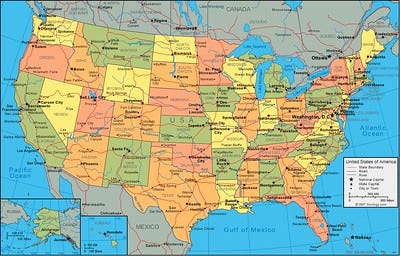#2: CIVICS 101: On Democracy and Its American Interpretation
Q&A #2: What form of government do we have in the United States?

Our American Government
Our American Government is a small book published by the House of Representatives for citizens and those who seek a greater understanding of the American interpretation of democracy. It follows a question-and-answer format and covers a broad range of topics dealing with the three branches of our Government, the electoral process, and the role of political parties.
The Savvy Citizen is reproducing the 169 questions-and-answers through a series of posts called Civics 101. Each post will contain the Q&A as well as some additional commentary to add historical context, fun facts, or anything we believe will add to our collective understanding of these topics.
Think of it as your adult Civics class, but without the test!
Let’s keep at it.
SECTION: Democracy And Its American Interpretation
Q&A #2. What form of government do we have in the United States?
The United States, under its Constitution, is a federal, representative, democratic republic, an indivisible union of 50 sovereign States. With the exception of town meetings, a form of pure democracy [citizens vote directly, not through representatives], we have at the local, state, and national levels a government which is:
‘‘federal’’ because power is shared among these three levels; ‘
‘democratic’’ because the people govern themselves and have the means to control the government; and
‘‘republic’’ because the people choose elected delegates by free and secret ballot.
—
My Thoughts
For me, the term “federal” is the most significant descriptor. When used as an adjective, it means one thing, when used as a noun, it means something else. For example, when referring to the “federal government,” federal is describing a type of government where power is distributed between a central authority (national) and constituent units (states). When used as a noun, i.e. “the Federals,” it’s refers to those who support the national government, i.e. soldiers who fought for the U.S. Army during the Civil War were the Federals.
In the United States, we have a “federal” government (as opposed to a socialist or communist government) because the central authority (the three branches of the national government established in the Constitution) and the 50 states (the individual, independent, state governments) share power. One isn’t superior to other, at least in theory! :-)
Make no mistake, there is a vigorous power struggle between those who support a strong central authority (aka, the State) and those who support more evenly dispersed power across the states (aka, the People). This tension undergirds and permeates all of American politics.
The “left” is traditionally aligned with a central authority that makes decisions for the entire country, and the right is traditionally aligned with increased state authority that allows each state to make decisions that affect their respective citizens. Put another way, the left tends to support more national decision-making that creates uniform laws and norms for everyone, whereas the right tends to support local decision-making that allows communities to decide what works best for them. These are broad generalizations, but hopefully they illustrate the point.
It’s a battle royale, and always has been!
The Federalist Papers and Anti-Federalist Papers (responses to The Federalist Papers) written at the time of the founding articulates these positions very well. IMHO, there are benefits and drawbacks to both and a healthy mix usually presents the best outcomes.
—
Back tomorrow with Q&A #3: What is the role of the citizen in our Government?
xo,
Kelley for the Savvy Citizen Team
October 8, 2024




